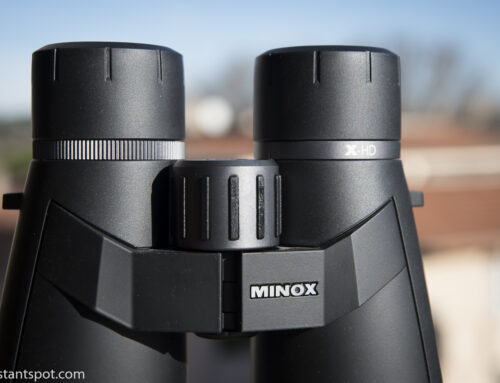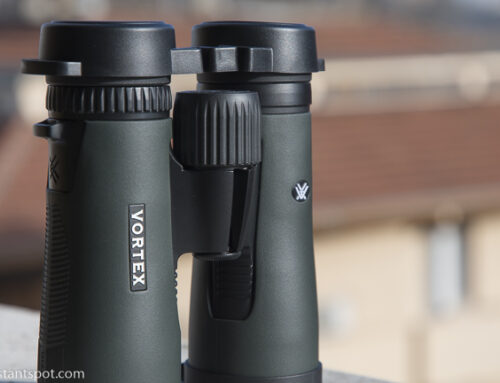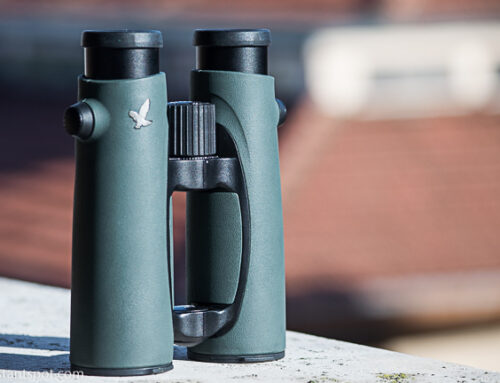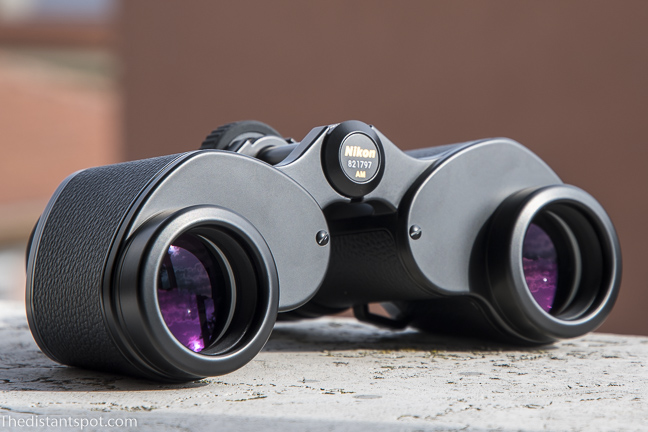Nikon 8×30 EII
Construction
Comfortable to grip, the porro prism optical scheme makes the Nikon 8×30 EII large enough to hold tightly. On the other hand, they are quite short, so those with big hands may feel a bit constrained. Anyway, resting my little fingers over the lenses seemed comfortable enough to me.
The focus ring is thin compared to the other binoculars I have tried. Furthermore, being of small diameter, depending on how you hold the binoculars it may be necessary to move your hand to rotate it. Overall quite uncomfortable.
The hull is not rubberized and this makes it clear that the project of these binoculars is quite dated. Many parts are simply uncoated metal, while the barrels are covered in faux leather that should make them easier to grip while serving aesthetic purposes, but which do not make them softer.
The lack of a rubber coating has meant that, following a collision that I didn’t even notice, a small piece of paint, at the base of a lens, came off, exposing the underlying metal (which I hope will not deteriorate).
 Optical qualities
Optical qualities
The sweet spot of the Nikon 8×30 EII is large enough and covers at least 50% of the image. The areas of the frame that are less sharp are due to the physiological curvature of the field, since the objectives are not equipped with a field flattener.
The field stop is precise and the drop in brightness on the edge, while present, seems very limited.
The most important feature of this pair of binoculars, anyway, is the field of view. It amounts to 8.8 degrees and is a pleasure to watch: it is big, immersive and mostly correct. Not an easy task to accomplish.
Chromatic aberration
It is quite reduced to the center of the image. Not like the Kowa BD 8×32 Prominar XD which is my reference, and in any case more present than in the Swarovski EL 8.5×42 W B. As you move away from the center, a small purple or green outline appears along the tree line, but neither very noticeable nor annoying. Jupiter, brought to the edge of the field, shows a blue reflection which, however, is hidden by the significant amount of coma that makes the planet a line.
Birds of prey, observed against the bright background of the sky, show a slight violet halo, quite visible but not too annoying, although I expected less.
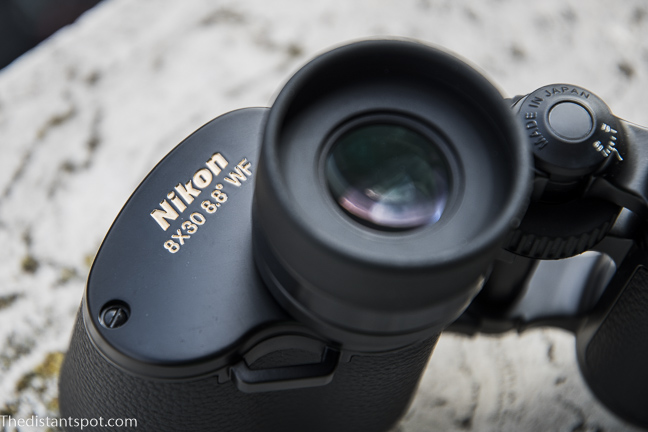 Sharpness
Sharpness
Good, almost excellent in the center: a clean, contrasted, pleasant image. The moon appears detailed, although in the Swarovski everything is more evident, almost hyper-realistic. Moving it from the center it begins to lose definition a little, but the effect is more prominent when you move it down, while the top side of the frame seems to work slightly better. In general, however, the image seems sharp up to 50% from the edge: it is not a lot, but keep in mind that the field of view is very large. And above all, the decline never becomes too pronounced, so that the image remains clearly legible even at the edge. The Kowa BD II 6.5×32 XD suffered significantly more and costs only 20% less.
Astigmatism
Excellent results, the stars are really point-like. Compared to the Swarovski I have not noticed any significant differences. The spectacle of the starry sky is very beautiful even from the city.
 Coma
Coma
Jupiter remains more or less spherical up to half of the field of view. If you bring it to the edge of the field it flattens out into a line (not very long, actually). The Swarovski performs much better from this point of view, but the price difference is very significant.
Tint
I read that it should tend towards red, but it didn’t seem very apparent to me: the moon looks the same color it looks with the Swarovski. Even during the day, the tint seemed essentially neutral, without dominants. Perhaps the bark of a pine looked slightly redder than it should, but it doesn’t seem too obvious.
Reflections and stray light
Unfortunately the Nikon 8×30 EII suffer badly from side lights. The setting sun, 90 degrees to my left, produced a fairly annoying reflection in the left eyepiece. The moon also produces reflections, but not when it is just outside of the image: when it is a little further away, about 45 degrees away.
One thing I didn’t remember: Porro prisms don’t generate spikes! Fantastic!
Looking at the starry sky, the lights of the street lamps outside the frame (let’s say at least 45 degrees below) generate many reflections and a haze of background light that is quite annoying.
 Distortion
Distortion
Present. Looking at a wall or straight lines, a certain pincushion distortion is very evident (in the sense that the image seems to swell out, moving away from the observer).
Other aspects
Eye placement is quite crucial and delicate. Small movements produce drops in sharpness and brightness, while more pronounced movements lead to inevitable blackouts. The convenience of observation suffers a little.
The focus is short in the sense that once focused at 15 meters, everything appears ALMOST in focus to infinity. Only minimal corrections are needed.
The carrying case is ugly but, what matters most, it is huge: the binoculars are not small and the case certainly does not help. The eyepieces do not have caps but are covered by a single piece of plastic: uncomfortable and cheap looking (is there a reason for that? Something I’m not aware of?).
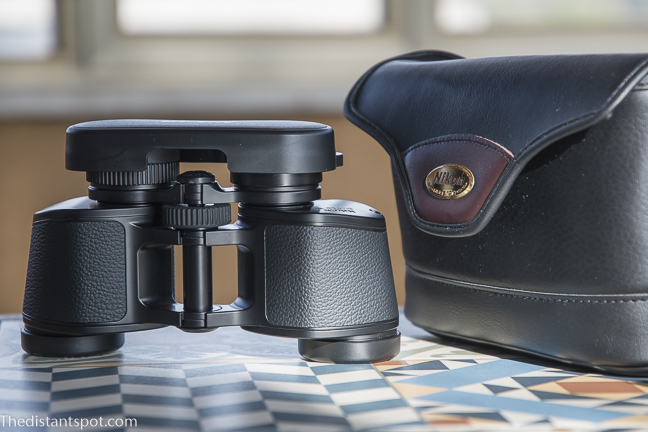 Conclusions
Conclusions
The Nikon 8×30 EII are in many ways difficult to judge. Although they are not without flaws, they have strong optical qualities and a very large field of view that is mostly usable. The construction, however, definitely shows its age. The porro prism optical design makes them more bulky and they lack widespread features that, in some cases, have practically become standard: a rubberized hull, an oversized focus ring, waterproofing and nitrogen filling. The carrying case is also uncomfortable and does not facilitate transport. Moreover, perhaps also due to their reputation, they are quite expensive. An updated version assessing these problems would be truly outstanding. All in all, however, these are excellent binoculars and are among the ones I have decided to keep.
Nikon 8×30 EII
Construction
Comfortable to grip, the porro prism optical scheme makes the Nikon 8×30 EII large enough to hold tightly. On the other hand, they are quite short, so those with big hands may feel a bit constrained. Anyway, resting my little fingers over the lenses seemed comfortable enough to me.
The focus ring is thin compared to the other binoculars I have tried. Furthermore, being of small diameter, depending on how you hold the binoculars it may be necessary to move your hand to rotate it. Overall quite uncomfortable.
The hull is not rubberized and this makes it clear that the project of these binoculars is quite dated. Many parts are simply uncoated metal, while the barrels are covered in faux leather that should make them easier to grip while serving aesthetic purposes, but which do not make them softer.
The lack of a rubber coating has meant that, following a collision that I didn’t even notice, a small piece of paint, at the base of a lens, came off, exposing the underlying metal (which I hope will not deteriorate).
 Optical qualities
Optical qualities
The sweet spot of the Nikon 8×30 EII is large enough and covers at least 50% of the image. The areas of the frame that are less sharp are due to the physiological curvature of the field, since the objectives are not equipped with a field flattener.
The field stop is precise and the drop in brightness on the edge, while present, seems very limited.
The most important feature of this pair of binoculars, anyway, is the field of view. It amounts to 8.8 degrees and is a pleasure to watch: it is big, immersive and mostly correct. Not an easy task to accomplish.
Chromatic aberration
It is quite reduced to the center of the image. Not like the Kowa BD 8×32 Prominar XD which is my reference, and in any case more present than in the Swarovski EL 8.5×42 W B. As you move away from the center, a small purple or green outline appears along the tree line, but neither very noticeable nor annoying. Jupiter, brought to the edge of the field, shows a blue reflection which, however, is hidden by the significant amount of coma that makes the planet a line.
Birds of prey, observed against the bright background of the sky, show a slight violet halo, quite visible but not too annoying, although I expected less.
 Sharpness
Sharpness
Good, almost excellent in the center: a clean, contrasted, pleasant image. The moon appears detailed, although in the Swarovski everything is more evident, almost hyper-realistic. Moving it from the center it begins to lose definition a little, but the effect is more prominent when you move it down, while the top side of the frame seems to work slightly better. In general, however, the image seems sharp up to 50% from the edge: it is not a lot, but keep in mind that the field of view is very large. And above all, the decline never becomes too pronounced, so that the image remains clearly legible even at the edge. The Kowa BD II 6.5×32 XD suffered significantly more and costs only 20% less.
Astigmatism
Excellent results, the stars are really point-like. Compared to the Swarovski I have not noticed any significant differences. The spectacle of the starry sky is very beautiful even from the city.
 Coma
Coma
Jupiter remains more or less spherical up to half of the field of view. If you bring it to the edge of the field it flattens out into a line (not very long, actually). The Swarovski performs much better from this point of view, but the price difference is very significant.
Tint
I read that it should tend towards red, but it didn’t seem very apparent to me: the moon looks the same color it looks with the Swarovski. Even during the day, the tint seemed essentially neutral, without dominants. Perhaps the bark of a pine looked slightly redder than it should, but it doesn’t seem too obvious.
Reflections and stray light
Unfortunately the Nikon 8×30 EII suffer badly from side lights. The setting sun, 90 degrees to my left, produced a fairly annoying reflection in the left eyepiece. The moon also produces reflections, but not when it is just outside of the image: when it is a little further away, about 45 degrees away.
One thing I didn’t remember: Porro prisms don’t generate spikes! Fantastic!
Looking at the starry sky, the lights of the street lamps outside the frame (let’s say at least 45 degrees below) generate many reflections and a haze of background light that is quite annoying.
 Distortion
Distortion
Present. Looking at a wall or straight lines, a certain pincushion distortion is very evident (in the sense that the image seems to swell out, moving away from the observer).
Other aspects
Eye placement is quite crucial and delicate. Small movements produce drops in sharpness and brightness, while more pronounced movements lead to inevitable blackouts. The convenience of observation suffers a little.
The focus is short in the sense that once focused at 15 meters, everything appears ALMOST in focus to infinity. Only minimal corrections are needed.
The carrying case is ugly but, what matters most, it is huge: the binoculars are not small and the case certainly does not help. The eyepieces do not have caps but are covered by a single piece of plastic: uncomfortable and cheap looking (is there a reason for that? Something I’m not aware of?).
 Conclusions
Conclusions
The Nikon 8×30 EII are in many ways difficult to judge. Although they are not without flaws, they have strong optical qualities and a very large field of view that is mostly usable. The construction, however, definitely shows its age. The porro prism optical design makes them more bulky and they lack widespread features that, in some cases, have practically become standard: a rubberized hull, an oversized focus ring, waterproofing and nitrogen filling. The carrying case is also uncomfortable and does not facilitate transport. Moreover, perhaps also due to their reputation, they are quite expensive. An updated version assessing these problems would be truly outstanding. All in all, however, these are excellent binoculars and are among the ones I have decided to keep.


